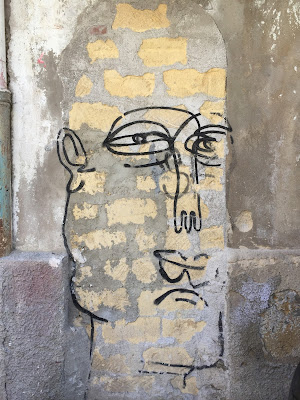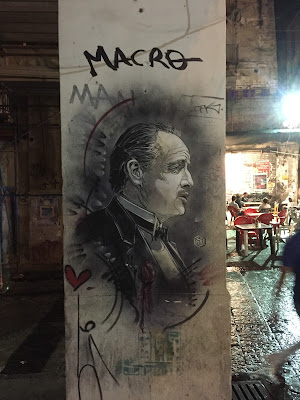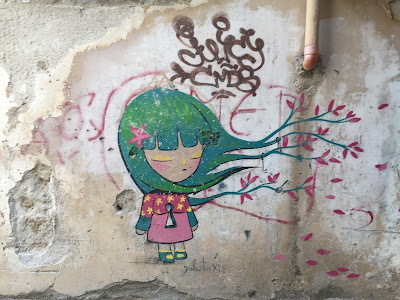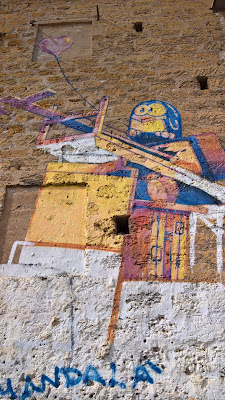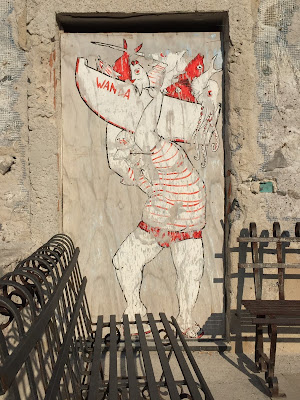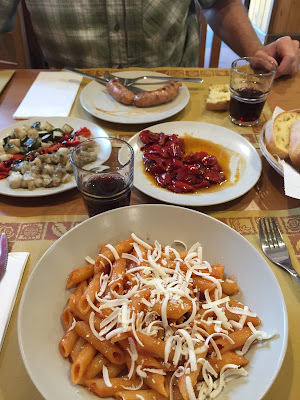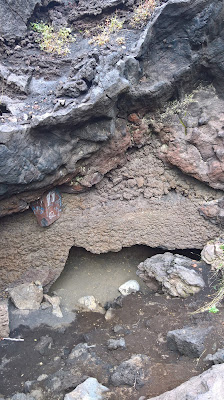For this episode of Street Sign Language Lesson, we head to Sicily. Over two weeks, we visited Palermo, several of the Aeolian Islands, and did several hikes around Mount Etna. In this post we talk about signs and words on them that convey a little of the flavor of our trip including ash (
cenere) and sand (
sabbia) of Etna, pumice (
pomice) and obsidian (
ossidiana) of Lipari, dressed-up bread (
pane cunzato), and (
avvistamento incendi) fire lookout.
Around Mount Etna
Fire spotters at Rifugio Citelli.

Avvistamento incendi boschivi – forest fire watch
We had just finished a hike from the
Rifugio Citelli to Grotta di Serracozzo and two men in a little shack caught our eye. We just had to see what they were doing. As we walked closer, we saw the writing on the side of the shack that indicates they are keeping an eye out for fires and they explained as much when we asked. They told us that most of the fires are arson, not naturally occurring.
Several days earlier, we were in the Aeolian Islands and the subject of fire came up several times. We’d see land that looked recently scorched (e.g., on Lipari) and we would ask about it. There too, it seemed that the answers we got were that the fires are set deliberately. One person told us it was for hunting. Another person we asked said it was a typical Sicilian revenge tactic.
Just this June there were an unbelievable number of fires across Sicily, now believed to have been arson. See for example,
Firefighters in Sicily battle dozens of blazes which officials believe were deliberately lit by the mafia, developers - or even forest rangers and
Mafia 'attaching flaming rags to cats' to start Sicily forest fires. Gulp.
Gatti piromani – arsonist cats. Behind the fires there is a money motive, it’s just not clear as of yet what it is.
Signs on the roads around Mount Etna warning of volcanic sand and ash.

 cenere vulcanica, sabbia vulcanica – volcanic ash, volcanic sand
cenere vulcanica, sabbia vulcanica – volcanic ash, volcanic sand
We stayed near Milo at B&B
Dimora dell’Etna and noticed many signs warning about volcanic sand and ash as we drove around the mountain. First, it’s difficult to appreciate just how big Etna is, and secondly, how the landscape can change in an instant. Volcanic ash and sand can make roads slippery, reduce visibility, not to mention the damage to the car itself.
Mount Etna funivia warning to behave.
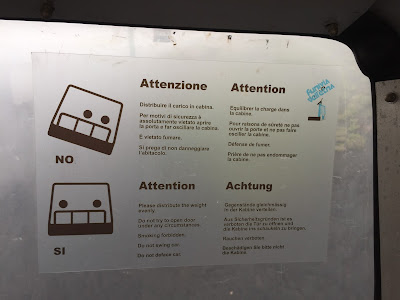
distribuire il carico in cabina – distribute weight evenly in the cabin
We saw this sign on the
funivia on the way up to Mount Etna’s summit for a
crater summit hike. The image of the tilted cabin made me think of two American lovers riding in a pickup, scrunched over toward on the driver's side of the vehicle. Lovers: please separate.


Vietato oltrepassare questo limite – It is forbidden to go beyond this limit
You cannot go above 3000 m on Etna without a guide, or you could, but it is highly discouraged and foolhardy. Anyhow, why not just go up with a guide and get the experience that goes with that? We were on the
summit crater tour when we saw this sign. Later as our group was well beyond the 3000m limit (with our guide) a lone person much lower on the trail seemed to be trying to catch up with us thinking perhaps they could join our group. A park ranger or guide ran after her, yelling, and finally escorted her back down. The person was trying to go it alone.
Oltrepassare is to
passare oltre or pass over a limit,
limite – masculine – so we use
questo.
Lipari
A bowl of salt for driving away evil spirits.

fora malocchio – away with the evil eye
We saw this sign in Chitarra Bar in the old marina of Lipari. For the few days we were in Lipari, we seemed to end up there every morning for an after-breakfast and before-you-start-your-day granita and brioche. Chitarra Bar a great place to watch the tours depart for the day and scuba students getting ready to go out. In the Sicilian language,
fora is equivalent to the Italian
fuori, or out, as in the exclamation "out!"
Malocchio is the evil eye or a hex or jinx. This sign was over a dish of salt where one takes a pinch of salt and throw it over the shoulder to get rid of some bad juju. It’s fairly noticeable (at least for us) the uptick in superstitious beliefs as you travel from north to south in Italy. Here’s one example of a
superstitious ritual (see video).
Obsidian and pumice for sale in Lipari.

ossidiana, pomice – obsidian, pumice
You can’t visit the islands, especially Lipari, without running into these words. They define the islands.
Obsidian on Lipari is one of the major deposits in the Mediterranean for this volcanic glass. It was important in the early Neolithic settlements of the islands for creating cutting and piercing tools, and for trading for goods from the mainland (like clay for pottery).
Pumice is another volcanic product that is common on Lipari. There was an important production site for pumice on Lipari, which is now closed. As explained on the site
Real House Wife Adventures, the site was closed because of the UNESCO designation that was bestowed on the Aeolian Islands. We also heard this reason when we visited the interesting exhibit inside the Chiesa dell' Immacolata (Castello di Lipari) called “
Lipari 1952 – Viaggio nelle cave di pietra pumice - photographs by Cecilia Mangino” running from July 28 to September 10 2016. The young local guy running the exhibition that day echoed the same reason. A double-edged sword: an activity like pumice quarrying that is unique to the island is the very thing that must be curtailed to preserve its status on a World Heritage List. We read that it was because of the dust produced and the pumice debris that clouded the otherwise clear waters. (If you want to read more see the
documentation on the UNESCO site for the islands.)
Rescue boat at Coral Beach, Island of Lipari.

salvataggio - rescue
I liked this picture of the boat resting on the beach. nobody needed saving while we were passing by on this calm morning. We rented a scooter and toured Lipari, with a stop here at Coral Beach.
Salina
Restaurant on the Island of Salina advertising pane cunzato.

Pane cunzato – is a cross between a bread salad, open-faced sandwich, and bruschetta; the literal translation is something like “dressed up bread”
We started noticing this Sicilian specialty,
pane cunzato, in Lipari when we rolled into town our first night (hydrofoil
aliscafo from Palermo to Lipari). We weren’t very hungry but wanted something to snack on. We ate
pane cunzato at Il Gabbiano in the old marina. Later, we realized almost every restaurant has a version of
pane cunzato.
Vulcano
Warning sign at the start of the ascent to the Gran Cratere.
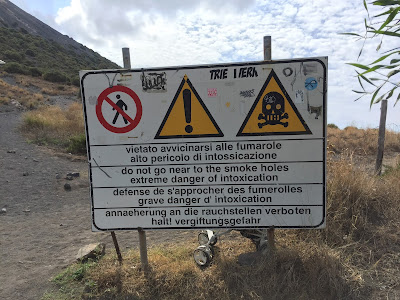
Vietato avvicinarsi alle fumarole alto pericolo di intossicazione – It is forbidden to get close to the fumaroles due to danger of poisoning
It’s easy to read
intossicazione as intoxication whereas here it means poisoning.The fumaroles in question are on the Gran Cratere of the Island of Vulcano that
we hiked up to. The most that happened to me was I got slightly burned on the leg by gas coming from a fumarole trying to get by an annoying group of French tourists who would not get out of the way and kept shouting “incroyable!” Grrr. Note the baby stroller parked behind the sign.
Inspirational graffiti at the summit of the Gran Cratere on the Island of Vulcano.
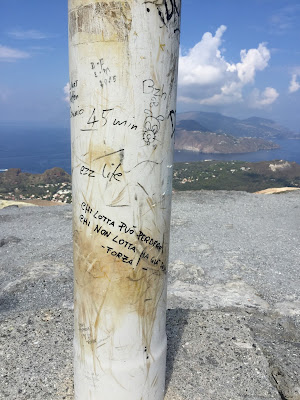 Chi lotta può perdere, chi non lotta ha già perso – forza! – Those who fight can lose, those who don’t have already lost – Onward!
Chi lotta può perdere, chi non lotta ha già perso – forza! – Those who fight can lose, those who don’t have already lost – Onward!
I'm a sucker for inspirational graffiti, I admit it. We saw this written on the high point of Gran Cratere of Vulcano. It’s a crater you can “get to the top of” without a guide as compared to Stromboli and Etna, where you must have a guide.
Lottare – to fight or struggle is a useful verb to know.
Stromboli
Signs on Stromboli showing which way to go in the event of a tsunami.

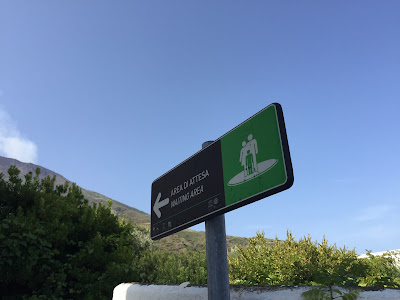
via di allontanamento, area di attesa – escape route, waiting area
We were walking along Via Regina Elena on the morning before our
hike to the summit, one of the two main streets in Stromboli, and kept seeing these signs. We later learned from our hiking guide that tsunamis are a serious threat as happened in 2002 after the collapse of part of the crater causing a landslide at the Sciara del Fuoco. The wave caused by the material sliding in the ocean reached around the other side of the island causing damage.
We also noticed that these signs are very useful for finding the hidden beaches in Stromboli. Walking along Via Regina Elena, you see a lot of stairs and narrow lanes leading to the sea, but you might be uncertain if they are public or private. If you see these signs, it’s likely a public beach.
Palermo
Sign in a driveway in Palermo to leave doorway clear.
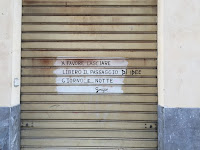 x favore lasciare libero il passaggio (di idee) giorno e notte – please leave the doorway clear (of ideas) day and night
x favore lasciare libero il passaggio (di idee) giorno e notte – please leave the doorway clear (of ideas) day and night
x is shorthand for
per or "for". I like the way someone tacked on
di idee.



